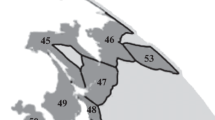Abstract
A problem of locating and comprehensively investigating ocean areas that exercise a significant influence over the migration dynamics of fishing ranks among important problems of fisheries oceanology. Among all the environment factors affecting various fishery situations, factors should be chosen that are constantly logged on large water areas for a long time comparable with fishery observation time. As described in a number of works, the most suitable information for these purposes is data on the distribution of surface temperature fields.
The problem of locating discriminative areas can then be stated as follows. For a particular fishery situation (e.g., for the period of maximum catch in fishing season), temperature values or thermostructural features should be singled out that are suitable to define the situation, using hydrological charts of surface temperature fields. Correlating the feature with the areas where they were observed, we will obtain discriminative areas.
The important problem is then to develop techniques and means for algorithmically identifying areas. This relates to a vast volume of information and complex structure.
Logical-mathematical models of locating discriminative areas are being developed at the Pacific Oceanological Institute for some years. These models are to be for forecasting fishery situations in the NW Pacific. Techniques for representing isotherm fields in a computer have been developed. Formal operations of comparing the fields have been proposed which aid in distinguishing significant differences in their structure. A software for analyzing isotherm fields has been developed based on threshold logic models.
This approach allows one not only to identify discriminative areas for relatively stable fishery situations but also to trace their dynamics. This has been achieved due to multiple-alternative computations and the presentations of data obtained in the form suitable for their interpretation. Some components of proposed models have been used in the system of short-term forecasting saira and sardine fishery in the South-Kuril area.
Similar content being viewed by others
References
Bongard, M.M.: Problems of Recognition. Moscow, Nauka (1967)
Voronov, A.A.; Goldman, R.S.; Ilyichev, V.I.: Algorithmic methods in fishery areas predictions in the ocean. Automation and Telemechanics 5, 146–157 (1985)
Goldman, R.S.; Ilyichev, V.I.: Methods of fisheries accumulation prediction in the ocean based on ocean variation analysis. Reports of the Academy of Sciences, USSR, 267,3, 737–739 (1982)
Goldman, R.S.: Logarithmic diagnosis models of continuous objects. Automation and Telemechanics 5, 149–156 (1979)
Parkhomenko, P.P.: Foundations of technical diagnostics. Moscow, Energia (1976)
Smirnykh, L.P.; Slobodin, V.P.: A batch of applied programs for representation, input, storage and preliminary processing of hydrological ocean fields by a computer. Vladivostok, Far East Science Center, Academy of Sciences, USSR 1981.
Oceanographic Monthly Summary 1,6, 12–46 (1981)
Author information
Authors and Affiliations
Rights and permissions
About this article
Cite this article
Goldman, R.S., Smirnykh, L.P. & Yurasov, G.I. Algorithmic techniques of identifying discriminative ocean areas in oceanology problems. GeoJournal 16, 35–43 (1988). https://doi.org/10.1007/BF02626370
Issue Date:
DOI: https://doi.org/10.1007/BF02626370




